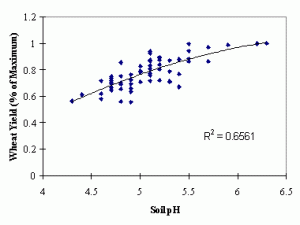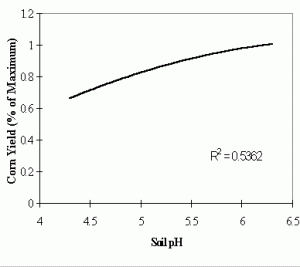How Soil pH Affects Wheat and Corn Yields
go.ncsu.edu/readext?355848
en Español / em Português
El inglés es el idioma de control de esta página. En la medida en que haya algún conflicto entre la traducción al inglés y la traducción, el inglés prevalece.
Al hacer clic en el enlace de traducción se activa un servicio de traducción gratuito para convertir la página al español. Al igual que con cualquier traducción por Internet, la conversión no es sensible al contexto y puede que no traduzca el texto en su significado original. NC State Extension no garantiza la exactitud del texto traducido. Por favor, tenga en cuenta que algunas aplicaciones y/o servicios pueden no funcionar como se espera cuando se traducen.
Português
Inglês é o idioma de controle desta página. Na medida que haja algum conflito entre o texto original em Inglês e a tradução, o Inglês prevalece.
Ao clicar no link de tradução, um serviço gratuito de tradução será ativado para converter a página para o Português. Como em qualquer tradução pela internet, a conversão não é sensivel ao contexto e pode não ocorrer a tradução para o significado orginal. O serviço de Extensão da Carolina do Norte (NC State Extension) não garante a exatidão do texto traduzido. Por favor, observe que algumas funções ou serviços podem não funcionar como esperado após a tradução.
English
English is the controlling language of this page. To the extent there is any conflict between the English text and the translation, English controls.
Clicking on the translation link activates a free translation service to convert the page to Spanish. As with any Internet translation, the conversion is not context-sensitive and may not translate the text to its original meaning. NC State Extension does not guarantee the accuracy of the translated text. Please note that some applications and/or services may not function as expected when translated.
Collapse ▲Soil pH is an important factor in determining crop performance in North Carolina. Low pH levels affect nutrients by converting them into forms that are not readily available to the crop. In addition, low pH levels can increase the solubility of plant toxic metals such as aluminum resulting in stunted growth and a general lack of plant vigor. Because the soils commonly found in the southeastern US tend to be highly weathered and average yearly rainfall is high, pH levels in the surface and subsoil horizons tend to be low. In the sandy soils of the coastal plain, native pH levels often average less than 5.5, and on organic soils pH levels below 3.8 have been found. Therefore, to obtain optimum plant growth it is critical that soils be limed to increase pH levels.
Current recommendations for soil pH levels depend upon the amount of aluminum in the soil. This varies by soil type. Following are the recommendations made by the North Carolina Department of Agriculture concerning target pH levels on different soil types:
| Soil Type (Crop) | Target pH |
|---|---|
| Mineral Soils | 6.0 |
| Mineral Soils | 6.2 |
| Mineral/Organic Soils | 5.5 |
| Organic Soils | 5.0 |
In planning when to apply lime and how much lime to apply, it is critical to understand the effect of pH levels on crop performance. Figures 1 and 2 show the response of wheat and corn to different pH levels. Yield reductions in both of these charts are expressed as the percent of maximum yield expected under the prevailing environmental conditions. It is important to recognize that potential crop yields are determined by the weather conditions experienced during the year. Therefore, it is difficult to determine the absolute yield reductions caused by low pH levels without considering the weather conditions. To determine the impact of pH levels in any given situation, first, determine the potential yield of the crop and then multiply that yield by the percent of maximum found for a given pH on the two figures presented here.
Fig. 1. The relationship between soil pH levels and wheat yields on mineral or organic soils in North Carolina. 
Fig. 2. The relationship between soil pH levels and corn yields on mineral or organic soils in North Carolina.
Lime recommendations are a function of soil class, target pH, current pH, level of acidity (Ac) and residual credit (RC).
Tons lime/acre = Ac x [(target pH – current pH)/(6.6 – current pH)] – RC
To calculate the lime recommendation, you need the following information. Target pH can be found in the table shown in this paper. Current soil pH and Ac values appear on the soil test report. RC is any amount of lime recently applied, reduced by a certain percentage for each month that has elapsed since application: 8% for mineral soils (MIN), 16% for mineral-organic soils (M-O) and organic soils (ORG). Residual credit decreases as the amount of time after the last lime application increases. After 12 months have passed since the last application of lime, the residual credit is 0.


